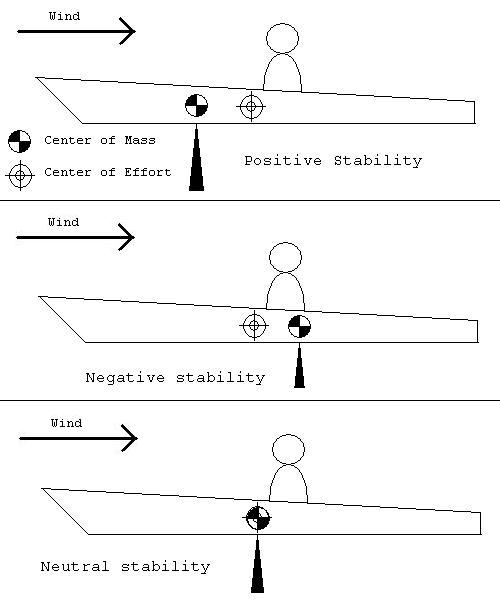Builders' Forum |
|
| ↓ Scroll to Last Comment ↓ | Forum Guidelines | Builders' Forum | |
The Chesapeake 16 I built for my wife has a significant weathercocking issue, like a dog whose hind legs try to pass the front ones.
I want to try adjusting the trim before making any major modifications, I just can never remember whether to add weight to the bow or stern to address this issue. Can someone please refresh my memory?
Thanks,
Mike
10 replies:
RE: Weathercocking
I was surfing kayaking sites and found the following about outfitting a kayak:
http://www.paddlinglight.com/articles/how-to-adjust-a-sea-kayak/
This part about seat adjustment and weathercocking caught my eye:
Moving the seat slightly forward or backward can significantly change the kayak’s performance. For example, when I first got my Explorer, I noticed that it weathercocked terribly, which no one complained about and wasn’t mentioned in any reviews. Most paddlers describe it as wind neutral. I decided to remove the seat and put a new one about 3/4 of an inch behind the old position. After I did that, the boat hardly weathercocks at all. If you move your seat, you’ll probably need to adjust any outfitting that you’ve already finished.
RE: Weathercocking
The center of mass (CG) is the boat's balance point. The boat acts as if it was sitting on a pivot at that point.
Thw wind acts on the whole boat, of course, but some points cancel out other points. The result of all the cancellations is that there is one point on the boat, called the center of effort (CE), where the net effect of the wind occurs. It's as if the wind was only pushing on that point.
If the CG and CE are not in exactly the same spot, the boat will rotate around the pivot until it is lined up so that the CG is closest to the wind with the CE behind it.
If the CG is in front of the CE, that is called positive stability because the front of the boat will always try to point into the wind. Weathercocking is too much positive stability.
CE in front of the CG is negative stability because the front of the boat will always try to point away from the wind.
When the CG and CE are at exactly the same point, that's neutral stability because the wind can't affect the direction of the boat.
If the stability configuration is wrong, all you have to do is move either center. You can move the CE by leaning forward or back. You can move the CG by packing weight further forward or back.
You can move both centers by moving the seat forward or back because the paddler is usually the heaviest object in the boat and has the greatest sail area for the wind to blow on.
One thing I've left out of this is what's going on underwater. There's buoyancy forces and underwater "sail" area. They also have their own centers and what really happens to the boat is a combination of CG, CE, CB (center of buoyancy) and CL (center of lateral area). But with a kayak, it's safe to assume that the CB and CL stay close enough to unchanged that the CG and CE position control weathercocking. But if you add a rudder, that's no longer true.
Good Luck,
Laszlo
PS - here's some drawings to show all this. Side and top views, paddling into the wind

RE: Weathercocking
I agree that moving the seat ever so slightly can make a big difference. For me, it was moving it back about 1/2 inch to find the sweet spot.
Weathercocking is harder to control if the boat is too big for your weight. Then you might consider loading water bottles both fore and aft.
-Wes
RE: Weathercocking
Lazlo,
My take from your comprehensive explantion, before my head exploded, is that putting more weight in the rear might help the weathercocking issue?
Bob,
Moving the seat is another option I would have considered if I hadn't cemented it into the boat already. So this option will have to be at the back of the line for now. We are experienced but not advanced paddlers.
Wes,
This boat should be just right for her above average weight. She has a low center of gravity, so boats I find twitchy she finds rock solid.
My solution of last resort is to add a rudder which could be problematic in a finished boat. I may not know enough profanity to go thru this process. I thought being retired now would give me unlimited time, but I seem to be busier.
Mike
RE: Weathercocking
I really like Laszlo's explanation and drawings. I've heard the best thing is to shift weight in back, but I didn't understand why.
I think you should tinker and see what works. Try putting a little weight in back and see if that helps. It should do the same as moving the seat back a little. If that doesn't work, try shifting the weight in front and see if that works.
Good luck.
RE: Weathercocking
Laszlo,
The drawings and explanation of CE/CB are great. I have made some adjustments, and I do see improvement in the control of my boat.
Thanks for all the help,
Chris F
RE: Weathercocking
If I ever suggested my wife had a low center of gravity, i'd be sleeping on the couch for a week!
RE: Weathercocking
Wes,
LOL, fortunately my wife is realistic about her weight, but trying to make suggestions about her paddling technique is another matter. That's why I'm better off making changes to the boat.:)
Mike
RE: Weathercocking
"fortunately my wife is realistic about her weight"
What planet is she from? I hope you do know her as well as you think! <grin>













RE: Weathercocking
» Submitted by careybob - Sat, 9/21/13 » 10:52 PM
Try some weight in the rear.
Are you experienced paddlers?